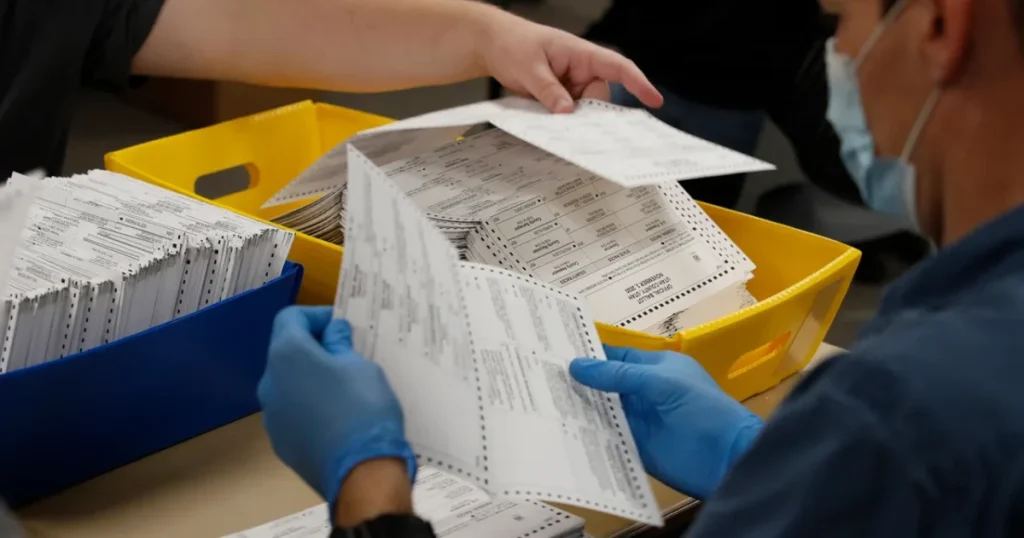Photo: Getty Images
As the 2024 presidential election approaches, concerns about the integrity and reliability of the U.S. Postal Service (USPS) in handling mailed ballots have resurfaced, Just The News reported.
A recent audit report by the USPS Office of Inspector General (OIG) has revealed significant procedural failures that could lead to delays or non-counting of mailed ballots in November.
The OIG report, titled Election Mail Readiness for the 2024 General Election, evaluated 15 mail processing facilities and 35 delivery units across 13 states and Puerto Rico during the primary elections held earlier this year.
Despite the USPS achieving a 97.01 to 98.17 percent on-time processing rate for political and election mail from December 2023 to April 2024, procedural non-compliance and operational risks remain significant concerns.
The audit revealed that personnel at numerous mail processing facilities and delivery units failed to adhere to critical procedures, including the proper completion of daily “all clear” certifications, maintaining accurate election mail logs, and conducting necessary audit checklists.
For instance, 12 of the 15 visited mail processing facilities did not complete their all-clear certifications correctly, which led to ballots being found in the facilities after the certification was supposedly completed.
In addition, the audit found instances where ballots were discovered in processing facilities and delivery units after the completion of the all-clear process. This indicates a significant risk that some ballots could be delayed, potentially missing the deadlines set by state election laws.
According to the report reviewed by The Gateway Pundit:
“We found 29 of 35 (83 percent) delivery units were inaccurately completing their certifications. Specifically, personnel at 26 of 35 (74 percent) delivery units were completing the AM all clear certifications prior to carriers leaving the unit and/ or completing the PM all clear certifications prior to carriers returning to the units.
We identified seven delivery units still had Election and Political Mail on hand after the certification, management at two units completed their certifications late, and three units’ certifications were completed by personnel not physically located at the unit. These latter three certifications should not have been completed, as the certifications require physical observations. We found between one and 87 pieces of Election and Political Mail in the delivery units. Specifically, two units had Political Mail on hand, and six units had Election Mail, which included ballots, on hand.”
Many employees at mail processing facilities were found to be unfamiliar with essential postmarking policies, with only 47% aware of these procedures. This lack of knowledge can lead to ballots being improperly processed or not postmarked at all, which is crucial for ensuring that votes are counted on time.
The audit also discovered that mail processing facilities did not maintain proper logs for election mail, which is vital for tracking and managing ballots effectively.
According to the report:
“We found mail processing facility and delivery unit personnel did not maintain logs correctly. Specifically, personnel at three of 15 (20 percent) mail processing facilities and at seven of 35 (20 percent) delivery units did not record any Election or Political Mail during the 2024 primary election cycle.
In addition, personnel at six of 15 (40 percent) mail processing facilities and at 17 of 35 (49 percent) delivery units used an outdated log, recorded required information incorrectly, and/or did not maintain photocopies of the mailpiece, as required.
We observed these logs positioned throughout processing and delivery facilities. They are typically completed by staff, but there was an overall lack of monitoring and oversight by management to ensure Election and Political Mail Logs were accurate and properly completed.”
Additionally, many facilities did not complete necessary daily checklists, further complicating the process of ensuring timely delivery.
According to the report:
Four of 15 (27 percent) mail processing facilities did not complete the Election and Political Mail audit checklist.
Two of 15 (13 percent) mail processing facilities indicated they had an Election and Political Mail Staging Area when no staging area existed.
Three of 15 (20 percent) mail processing facilities indicated they shared and posted service talks and e Processing Operations Management Order (POMOs) on the workroom floor with employees. However, we did not observe the posted 2024 service talks and POMOs.
The USPS OIG audit also highlighted several operational risks that could lead to delays in the processing and delivery of election mail.
For example, the Postal Automated Redirection System (PARS), which handles undeliverable mail, was found to contain undeliverable ballots at multiple facilities.
This backlog of PARS mail, in some cases, was months behind in processing, posing a significant risk that these ballots might not be returned to election offices in time to be corrected and counted.
Additionally, the audit identified confusion and lack of coordination on primary election days, leading to ballots not being separated and expedited for delivery. This lack of a streamlined process could result in ballots arriving too late to be counted.
According to the report:
“Four mail processing facilities did not have any processes to separate out ballots during primary election day for expedited processing. In addition, at one of these four facilities, management stated they were not aware of the state ballot receipt requirements.
[…]
We observed large volumes of PARS mail at four of 15 (27 percent) mail processing facilities, to include one facility with an estimated 300,000 pieces of PARS mail. Some of these facilities are designated hubs for PARS mail for their region. At two of these four facilities, we found Election Mail — undeliverable ballots being sent to voters — in the PARS mail.
During our fieldwork, we looked through a small, judgmental sample of PARS mail by conducting a random search of certain letter trays, rather than reviewing every piece of mail. At some of the facilities, PARS mail was about two months behind in processing. At one facility, we found one ballot in PARS, but this ballot did not have the required indication of why it was being returned to the sender.
In the other facility, we found 22 ballots in PARS mail going to the voter from the board of elections office. Postal Service policy states voter-returned ballots should not be in PARS; however, the policy does not speak to other types of Election Mail. While PARS mail is an area listed on the Operational Clean Sweep Search Checklist requiring review during the all – clear process, the volume of PARS mail we identified was so large it would have taken days to conduct an exhaustive search.”
The USPS OIG made ten recommendations to address the identified issues, including improving oversight and training, updating operational checklists, and clarifying policies and procedures. While the USPS management agreed with most recommendations, they disagreed with some, particularly those related to postmarking policies.
For more detailed information, refer to the full audit report by the USPS Office of Inspector General. Read below:
The post Will Your Vote Count in 2024? USPS Audit Reveals Some Mailed Ballots Might Be Delayed or Not Counted in November Due to Procedural Failures appeared first on The Gateway Pundit.







